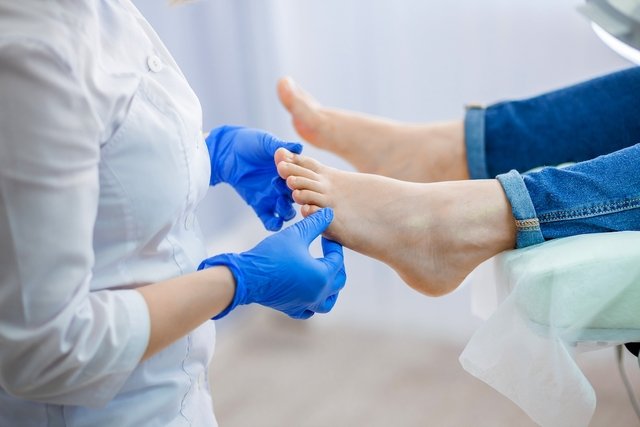Nail mycosis is a fungal infection of the toenails or fingernails, causing symptoms such as yellowish or whitish nails, thicker nails, detachment of the nail from the skin or the presence of a mass under the nail.
This infection, also called onychomycosis, can be caused by different types of fungi and occurs more frequently in people with uncontrolled diabetes, who have changes in blood circulation or who regularly use antibiotics.
Read too: Onychomycosis: what it is, symptoms, causes and treatment
The treatment of nail fungus is carried out by a dermatologist using antifungal medicines in the form of medicated nail polish or tablets, for example.

Symptoms of nail fungus
The main symptoms of nail fungus are:
- Whitish or yellowish nails;
- Increased nail thickness;
- More opaque, fragile and brittle nails;
- Nail that easily detaches from the skin;
- Nail deformities;
- Change in nail texture;
- Presence of a mass under the nail;
- Bad smell.
In the presence of these changes, it is recommended that a dermatologist be consulted so that the nails can be observed and the ringworm diagnosis can be made.
How the diagnosis is made
The diagnosis of nail fungus is made by a dermatologist through a physical assessment of the nail, observing its characteristics, in addition to evaluating the health history.
Make an appointment with the dermatologist in the region closest to you:
Taking care of your health has never been easier!
To identify the type of fungus that is causing nail fungus, the doctor can order a nail scraping exam and thus recommend the most appropriate treatment.
Possible causes
Onychomycosis is caused by different dermatophytes, such as Trichophyton rubrum, Trichophyton mentagrophytes and the Epidermophyton floccosumfor example.
Furthermore, yeasts such as Candida spp. and saprophytic fungi, such as Fusarium, Aspergillus, Acremonium, Scytalidium e Scopulariopsis brevicauliscan also cause nail fungus.
Who is most at risk of nail fungus
The main factors that increase the risk of nail fungus are:
- Uncontrolled diabetes;
- Weakened immune system, such as HIV infection or AIDS;
- Nail trauma from sports or tight shoes;
- Prolonged use of antibiotics;
- Poor blood circulation;
- Ringworm on the foot or Tinea pedis;
- Advanced age;
- Frequent contact with soap and water.
Furthermore, people who have a family history of nail fungus, are over 40 years old and/or do not have good hygiene habits, may also develop this type of infection more easily.
Types of nail fungus
The main types of nail fungus are:
1. Mycosis of a lateral distal subungual
Lateral distal subungual nail mycosis is the most common type of nail mycosis, mainly affecting the toenails, although it can less frequently affect the fingernails.
This type of nail mycosis is mainly caused by fungus Trichophyton rubrum and is characterized by the brownish-yellow color under the nail, on the side of the nail or at the tip, near the place where the nail is cut.
In addition, it presents detachment and increased thickness of the nail.
2. Mycosis of a proximal subungual
Proximal subungual nail mycosis occurs close to the cuticle region, leaving the nail with a thinner appearance, a whitish-yellow color, being more common on toenails and rarely affecting fingernails.
This type of nail fungus is usually caused by the fungus Trichophyton rubrum, being more common in people with a weakened immune system, such as in cases of diabetes, HIV or AIDS, for example.
3. White superficial mycosis
White superficial nail mycosis affects the most superficial layer of the nail, leaving it thin, with opaque white spots, which can affect the entire surface of the nail.
This type of mycosis is more common on toenails and in people with a weakened immune system, and is most often caused by the fungus Trichophyton interdigitale.
4. He ran on the nail
Nail candidiasis is caused by the fungus Candida albicans and generally starts in the soft tissues around the nail, spreading to the nail, mainly affecting the fingernails.
This type of mycosis leaves the nail with an irregular, rough appearance, with a whitish-yellow, green or black color, and may have redness in the tissues around the nail.
5. Mycosis of an endonia
Endoniacal nail mycosis, also called Endonyx, affects the nail plate, leaving the nail yellowish-brown, thick, but does not cause detachment of the nail.
6. Mycosis of a total dystrophic
Total dystrophic nail mycosis is considered the final stage of other types of nail mycosis, as it causes complete destruction of the nail.
Treatment for mycosis of the nail
Treatment for nail fungus must be carried out under the guidance of a dermatologist, and usually involves the use of antifungal medications.
The main treatments that may be recommended by your doctor are:
1. Use of antifungals
The main antifungals that may be recommended by your doctor are:
- Medicated nail polishessuch as amorolfine or ciclopirox olamine;
- Pillssuch as terbinafine or itraconazole.
In some cases, the doctor may recommend the combination of medicated nail polish and antifungal tablets, which varies depending on the severity of the nail fungus.
Read too: Ringworm medicine: ointments, lotions and tablets
2. Lasertherapy
Another treatment option is the use of laser, which is normally used in cases of chronic mycosis, which appears frequently.
This technique eliminates the ringworm fungus through the infrared rays emitted by the laser and is therefore quite effective, although it is a more expensive form of treatment.
Read too: How to treat nail fungus during pregnancy
How much time does the treatment last?
Treatment is usually quite time-consuming, because the fungus is only completely eliminated when the nail grows long enough.
Therefore, the cure usually arrives around 6 months for mycosis of the fingernails and 12 months for the feet, when followed correctly.
Home options to treat ringworm
Home treatment for nail fungus can be done by applying 2 to 3 drops of clove essential oil to the affected nail at least twice a day, as clove has antifungal and healing effects.
However, oregano or tea tree essential oils also have excellent action against this type of fungi and, therefore, can also be used.
Care during treatment
During the treatment of nail fungus, some precautions are important, such as:
- Avoid wearing tight shoes;
- Prefer cotton socks;
- Wash and dry your feet very well, including between the toes;
- Always wear flip-flops in swimming pools or public bathrooms;
- Use your own manicure or pedicure materials and do not share them.
These precautions speed up the treatment of nail fungus and prevent a new infection. This way, it can also be done even when you are undergoing the treatment recommended by your doctor.

Sign up for our newsletter and stay up to date with exclusive news
that can transform your routine!
Warning: Undefined array key "title" in /home/storelat/public_html/wp-content/plugins/link-whisper-premium/templates/frontend/related-posts.php on line 12
Warning: Undefined array key "title_tag" in /home/storelat/public_html/wp-content/plugins/link-whisper-premium/templates/frontend/related-posts.php on line 13



